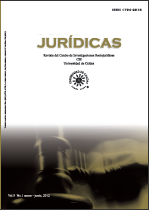Authors
Abstract
This article analyzesin a simplified way the role of the institutions in the context of economic growth; the core idea is that institutions and economic policy decisions influence economic growth with negative or positive incentives. The main objective of this analysis is to examine how an economic policy affected the Coffee Triangle region growth between 1985 and 2005. For this purpose we used Dani Rodrik’s (2007) crossed industry model which relates institutions represented in policy measurement and economic growth formally. Policy measurement is constructed from a proxy variable which measures the degree of the regional foreign trade economic opening, and economic growth is measured from the total factor productivity (TFP) estimation. As a conclusion a negative result of the political measurement (economic opening) is found in Caldas and Quindio economy, and a positive result can be observed in the Department of Risaralda.
Keywords
References
CÁRDENAS, Mauricio. 1993. “Crecimiento y convergencia en Colombia: 1950-1990”. Planeación y Desarrollo. Vol. 24. Edición Especial DNP 35 Años. Bogotá D.C. pp. 53-80.
De MATTOS, C. (1999). Teorías del Crecimiento Endógeno: lectura desde los territorios de la periferia. Brasil: Instituto de Estudios Avanzados.
DIXIT, Avinish. (1996) The Making of Economic Policy: A Transaction-Cost Politics Approach. Constitutional Political Economy. March 1998, Volume 9, Issue 1, pp 75-80
DIXIT, Avinish. (1999) Some Lessons from Transaction-Cost Politics for LessDeveloped Countries. Princeton University. First Draft June 1999
DIXIT, Avinish. (2001). “Some Lessons from Transaction-Cost Politics for LessDeveloped Countries”. Economics and Politics. No. 2, Vol. 15, pp. 107-133.
GLAESER, Edward, LA PORTA, Rafael, LÓPEZ, Florencio & SHLEIFER, Andrei. (2004). “Do Institutions Cause Growth?”. Working Paper Nº 10568, NBER.
GUELLEC, D. & RALLE, P. (1995). Les nouvelles théories de la croissance. Paris: La Découverte.
HODGSON Geoffrey M.(2006). What Are Institutions? Journal of Economic Issues. Vol. XL No. 1 March 2006.
KALMANOVITZ, S. (2001). Las instituciones y el desarrollo económico en Colombia. Bogotá: Norma, Colección Vitral.
MALDONADO COPELLO, Alberto. (2010). Desarrollo regional y políticas de promoción del desarrollo económico local: la experiencia de tres departamentos colombianos. Serie Estudios y Perspectivas No. 20. Bogotá: CEPAL.
NORTH, Douglass. (1990). Instituciones, cambio institucional y desempeño económico. México: FCE.
________. (1993). “Institutions and Economic Performance”. In: Rationality, Institutions and Economic Methodology. Routledge.
OHASHI, H. (2005). “Learning by Doing, Export Subsidies, and Industrial Growth: Japanese Steel in the 1950s and 60s”. Journal of International Economics. 66, pp. 297-323.
PARSONS, W. (2007). Políticas públicas: Una introducción a la teoría y la práctica del análisis de las políticas públicas. México: Flacso.
RODRIK, Dani. (1995). “Trade and Industrial Policy Reform”. En: J. Behrman and T.N. Srinivasan. Handbook of Development Economics. Vol. III. Amsterdam: Elsevier Science.
________. (2007). Normalizing industrial policy. Harvard University. Working Paper.
ROSENDE, Francisco. (2007). “El Papel de las Instituciones en el Crecimiento Económico: Reflexiones a partir de la Literatura Reciente”. Working paper No. 325. Universidad Católica de Chile.
RUBIO, Mauricio. (1999). Crimen e impunidad. Precisiones sobre la violencia. Bogotá: Tercer Mundo y Uniandes.
SALA-I-Martin, X. (1994). Apuntes de crecimiento económico. Antoni Bosh.
SALA-I-Martin, X. (2002). “La nueva economía del crecimiento: ¿Qué hemos aprendido en quince años?”. Economía Chilena. No. 2, Vol. 5, pp. 5-15.

 PDF (Español)
PDF (Español)
 FLIP
FLIP





















